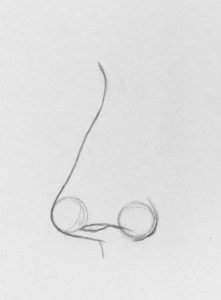What to consider when drawing a nose
To learn to draw a nose, one should first look at the individual elements of the nose. This gives you a better understanding of how the nose is shaped. With this knowledge, it is much easier to represent a nose realistically.
To a large extent, the shape of the nose is determined by the nasal bone and the nasal cartilage. Nasal cartilage lies roughly in the upper third of the nose and, together with the nasal bone, forms the nasal hump. This nasal hump is decisive whether the nose is straight or a hooked nose – of course, there are also all the steps in between.
In the drawing above, you can see the nasal hump very clearly. This also describes the other elements of a nose.
The second – already mentioned – cartilage that you have to pay attention to when drawing a nose is the tip of the nose. It can also take on very different shapes – round, pointed, wide, thin.
The nostrils are approximately at the same height and about the same size. They are round or spherical and, with their shape, form the nostrils.
When drawing the nose, it is interesting that the nostrils have a narrow oval when viewed from the side. The nostrils are a bit tricky to pull as they can quickly look strange if drawn too big. Incidentally, the nostrils are not generally round either. The nostrils can also have a more angular shape depending on the perspective from which the nose removes.
Draw the side view of a nose step by step

Now let’s move on to the first simple drawing exercise for drawing a nose. The easiest way to mark the nose is from the side.
In the side view, the nose corresponds roughly to a triangle – see picture below. If you want to learn to draw a nose, the first step is to sketch a triangle,
In the next step, you can sketch the tip of the nose and the nostrils by drawing two spheres.
Now give the triangle line, which represents the bridge of the nose, a characteristic contour. This also includes the nasal hump, which barely pronouns in the drawing below. It’s just an example because, as mentioned earlier, noses can look very different. Often the nasal hump is a little more pronounced than in this drawing example.
The nostrils drew in this step. I didn’t draw a closed oval but left the line open.
Draw the frontal view of a nose step by step
Drawing the frontal view – i.e., the view directly from the front – of a nose is a little more complicated. The characteristic shape of the nose is not particularly evident in the frontal view. Therefore, the representation is more complex, especially when the plastic form of the nose makes clear.
If you want to learn to draw a nose step by step, you can start again by pulling the approximate shape. To do this, remove a thin column representing the bridge of the nose and a triangle on each side, which means the sidewall of the nose and the nostrils.
In the second step, you can continue with circles and ovals as a guide. The nose is made up of three processes: a large one that represents the hump of the nose and two small circles that represent the wings of the nose.
In addition, the nose can divide lengthways into three thirds if you need additional help.
In the last step, the nose gets a realistic contour. The tip of the nose draw in, and the nasal septum below it. Here, too, I have shown the nostrils as open circles.
Two arches indicate the nasal hump. The end of the sidewall of the nose is also shown with an arch. You don’t have to draw this curve so clearly because the transition to the cheek is not an edge but somewhat rounded. For practice, however, it is not wrong to remove these arcs so clearly. In the last step, the unnecessary auxiliary lines can also erase.
Also Read: How to caramelise onions






30 thoughts on “How to draw a nose?”
Club21ids
(September 10, 2021 - 9:49 pm)fake military id cards sale
Abhimanyu
(September 16, 2021 - 5:02 pm)Hey Amir,
In this post, your description was very good well explained every term, thank you, and keep posting!!1
Kyle
(December 2, 2022 - 11:58 am)Awesome article.|
Galina
(December 4, 2022 - 10:31 am)Fantastic beat ! I wish to apprentice while you amend your site, how could i subscribe for a weblog web site? The account aided me a applicable deal. I had been a little bit familiar of this your broadcast offered vivid clear idea|
Tracy
(December 4, 2022 - 11:09 pm)I read this piece of writing completely on the topic of the difference of most recent and previous technologies, it’s amazing article.|
Lonny
(December 4, 2022 - 11:22 pm)It’s awesome in favor of me to have a website, which is good in support of my knowledge. thanks admin|
binance sign up
(June 4, 2023 - 7:26 pm)Your point of view caught my eye and was very interesting. Thanks. I have a question for you. https://accounts.binance.com/en/register?ref=P9L9FQKY
104.3 the fan
(November 3, 2023 - 10:41 pm)I think the admin of this site is really working hard for his website since here every stuff is quality based data.
Djurdjura FM
(November 4, 2023 - 6:38 pm)Great information shared.. really enjoyed reading this post thank you author for sharing this post .. appreciated
newsmax.com live
(November 7, 2023 - 6:55 pm)There is definately a lot to find out about this subject. I like all the points you made
bbc farsi
(November 9, 2023 - 11:59 pm)Very well presented. Every quote was awesome and thanks for sharing the content. Keep sharing and keep motivating others. Watch bbc farsi
24 NEWS
(November 11, 2023 - 2:30 am)Thank you for starting this up. This website is something that is needed on the internet someone with a little originality!
Will it ever be possible for time travel to occur?
(November 15, 2023 - 8:14 am)I am truly thankful to the owner of this web site who has shared this fantastic piece of writing at at this place.
live horse racing stream free
(November 15, 2023 - 8:18 am)Also I ve shared your site in my social networks!
BVZ_Moskva_s
(November 20, 2023 - 10:08 pm)Быстро возводимые здания: финансовая выгода в каждой детали!
В современном обществе, где секунды – доллары, экспресс-конструкции стали реальным спасением для коммерческой деятельности. Эти современные конструкции включают в себя высокую надежность, экономичность и молниеносную установку, что позволяет им превосходным выбором для разнообразных коммерческих задач.
Быстровозводимые здания
1. Молниеносное строительство: Секунды – самое ценное в предпринимательстве, и быстровозводимые здания обеспечивают существенное уменьшение сроков стройки. Это высоко оценивается в моменты, когда срочно нужно начать бизнес и начать получать доход.
2. Экономичность: За счет оптимизации процессов производства элементов и сборки на месте, затраты на экспресс-конструкции часто снижается, по сравнению с обычными строительными задачами. Это дает возможность сэкономить деньги и получить более высокую рентабельность инвестиций.
Подробнее на http://scholding.ru
В заключение, экспресс-конструкции – это идеальное решение для проектов любого масштаба. Они объединяют в себе эффективное строительство, экономию средств и высокую прочность, что сделало их наилучшим вариантом для фирм, готовых к мгновенному началу бизнеса и выручать прибыль. Не упустите возможность сократить издержки и сэкономить время, лучшие скоростроительные строения для ваших будущих проектов!
How to Listen to SiriusXM Radio Online
(November 26, 2023 - 9:04 pm)I just like the helpful information you provide in your articles
Newsmax TV Live
(November 27, 2023 - 12:51 am)Awesome! Its genuinely remarkable post I have got much clear idea regarding from this post
Fmugaw
(January 2, 2024 - 9:30 am)generic allergy medication list allergy medication better than allegra best allergy pill for itching
ppu-prof_Sa
(January 13, 2024 - 11:04 am)Наша бригада искусных исполнителей находится в готовности предъявить вам прогрессивные системы утепления, которые не только снабдят долговечную защиту от мороза, но и преподнесут вашему жилищу стильный вид.
Мы деятельны с новыми строительными материалами, сертифицируя продолжительный время эксплуатации и великолепные эффекты. Теплоизоляция облицовки – это не только экономия на прогреве, но и заботливость о окружающей природе. Энергосберегающие разработки, каковые мы производим, способствуют не только своему, но и поддержанию природных богатств.
Самое важное: Утепление дома цена за квадратный метр работа у нас открывается всего от 1250 рублей за м2! Это доступное решение, которое метаморфозирует ваш резиденцию в реальный уютный корнер с небольшими затратами.
Наши работы – это не исключительно утепление, это постройка площади, в где любой аспект преломляет ваш собственный манеру. Мы возьмем во внимание все ваши требования, чтобы осуществить ваш дом еще более дружелюбным и привлекательным.
Подробнее на http://ppu-prof.ru/
Не откладывайте заботу о своем ларце на потом! Обращайтесь к исполнителям, и мы сделаем ваш домик не только уютнее, но и модернизированным. Заинтересовались? Подробнее о наших делах вы можете узнать на сайте компании. Добро пожаловать в универсум уюта и качественной работы.
channel 5 singapore
(January 18, 2024 - 1:19 pm)As I website owner I believe the content material here is really good appreciate it for your efforts.cine 5
Live TV
(February 3, 2024 - 12:34 pm)Great information shared.eally enjoyed reading this post thank you author for sharing this post.Live TV
meydan racing commentary
(February 9, 2024 - 10:50 pm)I appreciate you sharing this blog.Really looking forward to read more.-das perfekte dinner online ansehen
Plisse_bix
(February 18, 2024 - 9:45 pm)Уважаемые Клиенты!
Предоставляем вам свежее концепт в мире стилистики интерьера – шторы плиссе. Если вы рассчитываете к превосходству в всякой аспекте вашего домашнего, то эти шторы окажутся непревзойденным паттерном для вас.
Что делает шторы плиссе столь единственными? Они совмещают в себе грацию, использование и практичность. Благодаря особой архитектуре, технологичным материалам, шторы плиссе идеально гармонизируются с для любого ложи, будь то хата, ложа, кухонное пространство или деловое поляна.
Закажите тканевые жалюзи плиссе – оттворите уют и превосходство в вашем доме!
Чем понравятся шторы плиссе для вас? Во-первых, их индивидуальный бренд, который прибавляет прелесть и шик вашему обстановке. Вы можете подобрать из разнообразных текстур, цветов и подходов, чтобы отметить уникальность вашего дома.
Кроме того, шторы плиссе предлагают обширный базар практических возможностей. Они могут управлять уровень освещения в месте, защищать от солнечного света, обеспечивать конфиденциальность и создавать уютную атмосферу в вашем доме.
Мы веб-сайт: http://www.tulpan-pmr.ru
Мы сами поможем вам отыскать шторы плиссе, которые прекрасно подойдут для вашего дома!
crazy hot deals
(February 22, 2024 - 4:48 pm)Thank you for great content. look forward to the continuation.Provecta Advanced for Cats Over 9 Lbs. (4 dose) Orange – Hot Deals
hey dudes for girls
(February 28, 2024 - 5:22 pm)Thank you for great article. look forward to the continuation. – hey dudes near me
зарубежные сериалы в хорошем HD качестве
(March 22, 2024 - 1:09 am)A fascinating discussion is worth comment. I think that you ought to write more on this subject, it might not be a taboo subject but usually people don’t speak about such topics. To the next! All the best!!
Seo-Ul-Mew
(March 25, 2024 - 12:54 am)Мы коллектив профессиональных SEO-оптимизаторов, специализирующихся на повышении посещаемости и рейтинга вашего сайта в поисковых системах.
Мы преуспели в своей деятельности и хотим поделиться с вами нашим опытом и навыками.
Какими преимуществами вы сможете воспользоваться:
• аудит сео москва
• Глубокий анализ вашего сайта и формирование индивидуального плана продвижения.
• Модернизация контента и технических аспектов вашего сайта для оптимальной работы.
• Постоянное отслеживание результатов и анализ вашего онлайн-присутствия с целью его совершенствования.
Подробнее https://seo-prodvizhenie-ulyanovsk1.ru/
Наши клиенты уже видят результаты: увеличение посещаемости, улучшение позиций в поисковых запросах и, конечно же, рост своего бизнеса. Мы предлагаем бесплатную консультацию, для обсуждения ваших требований и разработки стратегии продвижения, соответствующей вашим целям и бюджету.
Не упустите возможность увеличить прибыль вашего бизнеса в онлайн-мире. Свяжитесь с нами немедленно.
глаз бога тг
(April 10, 2024 - 6:46 am)Quality posts is the important to be a focus for the people to pay a visit the web site, that’s what this website is providing.
бот глаз бога телеграмм
(April 10, 2024 - 8:04 pm)Hi mates, how is all, and what you wish for to say concerning this piece of writing, in my view its actually remarkable for me.
hoka one one women's hiking shoes
(April 14, 2024 - 11:03 am)I appreciate you sharing this blog.Really looking forward to read more.